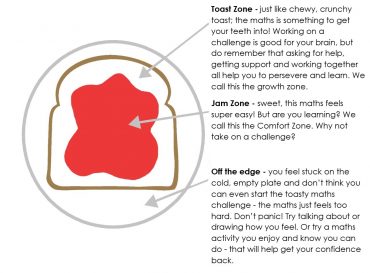Can getting better at maths be about feelings,
not facts?
Introducing the Toast Model for growing your maths brain
Here at Maths on Toast we want everyone to love doing maths. But we often get asked what to do when you (parent or child!) get stuck with some maths. Actually, most mathematicians are stuck most of the time – it’s how you feel about being stuck that can make all the difference.
As long as you’re not feeling panicked about it, being stuck is good for your brain. One way to think about that is the Toast Zone model.

You can find out more about how to work with children in the different Zones, and about the research behind the model, below.
Toasty tips for supporting your children and their feelings in each Zone:
Jam Zone
Activities where children feel confident and are successful but not challenged.
- Be proud of success – has your child always been able to do this kind of maths?
- Identify the value in the maths itself and in the learning skills that got them here. But if it’s not challenging for your child, try something harder!
Toast Zone
Where new learning happens. Learners need to take risks so they may make mistakes. Hopefully with the right resources and support they will feel confident enough to be able to persevere, acquire new skills and gain even more confidence.
Remember that support isn’t about providing, or even checking, the answer. It is about helping your child to find it for themselves, Your role is that of coach or supporter. If you don’t understand or remember the actual maths yourself, that needn’t matter.
Show positive attitudes towards maths. Even if you are finding the question challenging yourself, the feelings you show your child can support them to tackle the problem.
- A ‘can do’ approach – everyone is capable of increasing their mathematical ability!
- Empathy if it’s hard; that’s part of the learning. Praise resilience.
- Support for mistakes – they are there to learn from.
Try some of these prompts if your child seems stuck. Even when you are feeling unsure of the maths involved in the question, helping your child think about it differently could well be enough to help ‘unstick’ them:
- Have you encountered this type of problem before?
- What parts of the problem do you understand?
- Can you explain the problem to me?
- What have you tried already?
- What has helped you get unstuck in the past?
- How else could you represent the problem?
- Would it help to act out the problem?
- Would a picture or a diagram help solve the problem?
- Can you reword the problem and explain it in a different way?
- Would any specific resources help you, such as counters, cubes, a number line etc?
What about when you’re not there? Encourage children to work with a friend, in a group or ask for one-to-one help when they need it.
Off the edge
When we’re challenged beyond our current level of resilience we may find ourselves Off the edge. If your child is feeling helpless or upset, effective learning cannot take place.
- Help children recognise when they are feeling anxious. They will need to de-stress before the can return to the Toast Zone.
- Some de-stressing techniques might be:
- Writing down, drawing or talking about, how they feel.
- Using breathing techniques. (For example, closing eyes, breathing out for 7 seconds and in for 5.)
- Reminding them what they can do by doing another activity in their comfort zone.
The research that inspired the Toast Zone Model
The Toast Model is inspired by Sue Johnston-Wilder’s Growth Zone Model (Johnston-Wilder et al, 2015) – which is a framework for understanding different learning experiences and the feelings associated with each. The Growth Zone Model also has strong links to Growth Mindset (Carol Dweck 2012). Many schools will be aware, of or have implemented aspects of, growth mindset, so you might find that children are familiar with the ideas, language and strategies, which is great! Indeed, some schools will be actively involving parents too. However for many parents this will be a completely new concept – so here are some key points to note…
To develop Mathematical Resilience you need to:
-
-
-
-
- Believe that brain capacity can be ‘grown’
- Understand ‘the point’ of mathematics – how it is everywhere in our everyday.
- Understand how to work at mathematics – even when you are stuck!
- Know you have support from; resources, school, family
-
-
-
References:
– Johnston-Wilder, S. Lee, C., Brindley, J., & Garton, E. Developing Mathematical Resilience in school-students who have experienced repeated failure (2015)
– Mindset: How You Can Fulfil Your Potential, Professor Carol Dweck (2012)
Useful links to find out more…
– Sue Johnston-Wilder’s blog on maths resilience
– Ted Talk by Carol Dweck ‘The power of believing you can improve’
– www.mathematicalresilience.org
